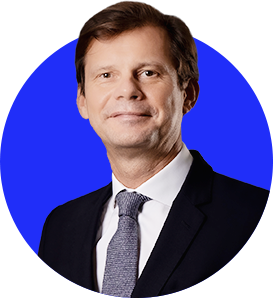Consolidating local hub models and maturing tech demand
Demand for IT staff dips after digital push; client asset consolidation continues.
In recent years, Luxembourg banks have consolidated their booking activities in the grand duchy, creating sales and distribution hubs that reach across Europe. Just under 60% of total assets under management comes from relationships managed elsewhere in the EU.
A slight increase in assets booked in other jurisdictions in 2022 may reflect asset performance rather than a reversal of that trend.
Equilibrium between outsourced and in-house approaches
When it comes to daily processes and activities, in-house employees are still the rule – just. The balance between internal and third-party providers is approaching equilibrium. That split has already tipped toward external suppliers for IT, turbo-charged by the uptake of cloud services.
Structurally, private banks are seeking to streamline and personalize their offering. Focusing on their core expertise in advice and investment will lead to increased operational outsourcing, particularly among wealth management specialists.
More investment specialists, fewer IT staff
Staffing remained consistent, despite wage cost pressures. Private banks employ around 5,400 staff in Luxembourg, with a further 1,300 working for branches and subsidiaries.
The focus on quality in advisory and discretionary management saw the number of investment specialists rise last year. Conversely, an earlier focus on digital and operational excellence is coming to an end: demand for operational and IT staff fell sharply, down 14%, as the impact of automation takes hold.
Universal Banks
Rapid rise in universal bank data costs outstrip jump in net income. Branchless model profitability soars as net interest income more than doubles.
Private banks in Luxembourg that are part of a larger universal banking group reported positive inflows of new customer investment money, and an increase in average client portfolio size while their total customer base shrank slightly.
Rising interest rates were good for business; net interest income rose almost 20% in 2022. The cost-to-income ratio remained relatively stable, albeit with significant variations. Those with traditional branch-based channels reported reduced efficiency gains.
Digital or physical, no universal bank was able avoid inflation, particularly for data costs (up 140%), compliance and staff. That applied equally to banks that use their group’s expertise for IT and other functions, or those solely focused on wealth management that are more likely to outsource.
Wealth managers without branches operated from Luxembourg
Branchless wealth managers doubled their net interest income . International customer base continues to expand.
Branchless business models were the outright winners on all fronts in 2022. Client numbers rose by 16%, mostly offsetting the impact of falling securities markets on investor portfolios. Clients with portfolios exceeding EUR 20 million make up almost three-quarters of the investor base.
While primarily focused on Europe, branchless wealth managers have made bigger inroads in international markets. The proportion of Latin American clients crept up to 8.89%, as did those from the rest of the world (10.39%).
More impressive was growth in net interest income, which more than doubled last year. Despite the impact of cost inflation, the revenue boost from interest income boosted profitability. The median cost-to-income ratio dropped by no less than 10.18 percentage points to 65.6%.
Wealth managers with branches that are not booking centers
European branch networks remain stable despite sector upheaval. Cost-to-income ratios improve significantly.
It’s been all change for specialist wealth managers who book their EU branch business in Luxembourg. Credit Suisse suffered significant outflows ahead of its acquisition by UBS, Intesa Sanpaolo and CBP Quilvest are set to merge, and HSBC brought its French private banking business under its Luxembourg umbrella last year.
Clients were largely unperturbed by the corporate maneuvering; assets under management dipped by just 6%. Although the share of assets from ultra-rich clients fell from 55% to 48%, their number increased.
Net income increased by three-quarters and operating profit by almost one-fifth. That helped to reduce the median cost-to-income ratio by 15.33 percentage points. However, at 80.69%, it remains far higher than that of branchless peers.
Wealth managers with branches that are also booking centers
Wealth managers with EU booking centers boosted cost efficiency.Local booking opens up additional revenue streams.
A shrinking number of wealth management-only private banks continue to book business in other EU member states, but they still represent a bigger share of client assets, at CHF147 billion, than those who book transactions in Luxembourg. After adjusting for market movements, we calculate that their total assets under management dipped by 8% last year.
nstitutions following this more traditional model are more likely to outsource functions such as IT. But they can also sell IT platform services to asset managers who want to register their client portfolios locally, and earn revenue from order execution and custody functions.
More conservative in nature, this cluster of wealth managers has tight cost controls. Overall operating expenses rose by just 5.31%, and employee remuneration by even less. With net income and operating income up, they cut their median cost-to-income ratio by 18.24 percentage points, a strong performance by comparison with other business models.





